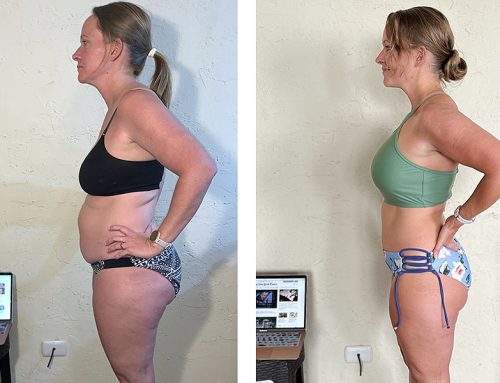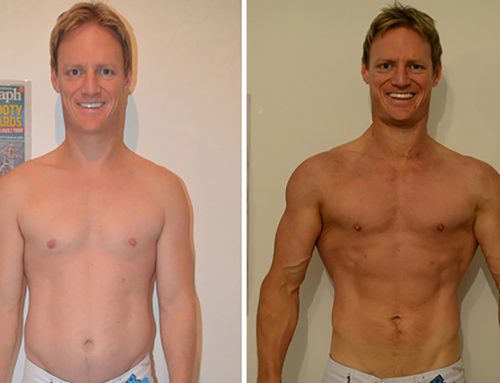Carb cycling is a nutrition tactic that’s been used by physique athletes and written about in diet books for years. Carb cycling is so widely embraced by fitness enthusiasts, you’d think it’s a foregone conclusion that it’s effective. But does carb cycling really work? And if so, a good question to ask is, how does it work? Many people believe carb cycling boosts your metabolism, but is that really true?
So far, most of the evidence that carb cycling works has been anecdotal. Athletes and dieters have simply been reporting their personal experiences and beliefs. The testimonials have been overwhelmingly positive. But until recently, there hasn’t been a scientific study that tested carb cycling in a form similar to what is commonly practiced. A new study has given us some new insights, suggesting carb cycling has benefits…

Even before this research was published, there’s always been a good theoretical basis for using carb cycling. Here’s why:
The traditional approach for weight loss is to stay in a calorie deficit (under maintenance) every day for an extended period. A continuous calorie deficit (aka “linear dieting”) works well in the short term. But over time, your body adapts to calorie restriction by reducing the calories you burn (you move less) and increasing your appetite (you eat more). So the longer you’ve been on the diet, the harder you find it to keep losing fat. Your body is basically fighting your efforts, trying to get your weight to stabilize.
Your body can adapt hormonally, metabolically and behaviorally. Most people don’t even consider this, but the biggest part of the adaptation is simply because you lost weight. One of the basic rules of energy balance is that smaller people burn fewer calories and bigger people burn more calories. When you lose weight, you’re a smaller person, so you burn less than you did before.
But with continuous dieting, metabolic rate also tends to decrease more than you’d predict based on how much weight you’ve lost. Scientists call this adaptive thermogenesis. The average layperson dieter sometimes calls it “starvation mode.” But that’s not a scientific term, and using that name while not understanding what metabolic adaptation really is has caused a lot of myths to be spread. (Which is why I stopped saying “starvation mode” and you should too).
When we talk about metabolic adaptation when dieting, we’re not saying that dieting too strictly makes your metabolism shut down. The idea that eating too little makes you stop losing weight is the “starvation mode myth.” The idea that you hold on to fat because you’re eating too little is actually ridiculous when you think about what happens when people really starve. They waste away to skin and bones.
What really can happen is your metabolism may decrease slightly so that you aren’t burning as many calories as you’d predict on paper (using calorie calculators). Continued weight loss gets slower, and even making minor mistakes or slipping a little on your compliance can cause a fat loss plateau.
In addition to slower metabolism, another challenge when dieting is maintaining your lean body mass (LBM), especially when your body fat is already getting low or when your calories or protein are low.
Non-Linear Dieting (aka Carb Cycling): A Diet Strategy To Preserve Muscle And Maintain Metabolism?
There’s only so much you can do about this adaptive decrease in metabolism. If you diet and lose fat, your metabolism is going to drop temporarily. Sorry, that’s how the ball bounces.
How much it affects you is based a lot on genetics. One person’s basal metabolic rate (BMR) may drop only a few percent, while some unlucky dude might see a 10 percent drop. Everyone burns fewer calories after a large weight loss. That’s just physics. There’s nothing you can do about that.
But there are two powerful and simple strategies to help you retain muscle when dieting:
1. Follow a progressive resistance training program consistently. (Even if your main goal is fat loss).
2. Eat enough protein.
If you cover these two bases alone, your risk of muscle loss is much lower. In already lean people, slow weight loss also reduces the risk of muscle loss. (Obese and overweight people can lose weight faster without as much worry about muscle loss).
Non linear dieting looks like it’s a third strategy for helping you hold on to precious muscle when dieting. It has also been promoted as a way to prevent your metabolism from slowing down as much.
Non linear dieting involves eating more for short periods, instead of staying in a calorie deficit continuously every day for the duration of the diet. Non-linear dieting is a broad term that includes more than one technique. It includes carb cycling (also known as refeeding), as well as diet breaks.
When the calorie increase is short term, typically only one or two days per week, this form of non-linear dieting is usually called a refeed. For example you might eat in a deficit for three days and then eat at maintenance for one day and then repeat the three days low, one day high cycle. Or you might eat for five days in a deficit and then eat two days in a row at maintenance.
On the higher calorie days, usually you’re advised to get the additional calories from carbs, which is why it’s referred to as carb cycling.
Carb Cycling/Refeeds Vs Diet Breaks: What’s The Difference?
When you increase your calories for a longer period, like one or two weeks at maintenance calories, this is a different type of non-linear dieting. This is referred to as taking a “diet break.”
Both types of non-linear dieting have been proposed as ways to reduce metabolic adaptation and reduce risk of muscle loss. That should help you get better results from your diet in the long term.
Only a handful of studies have been done on diet breaks, but they suggest significant benefits. For example, in the MATADOR study, one group of dieters ate in a 33% deficit for two weeks, then increased calories and ate at maintenance for two weeks. They repeated that cycle for months. Counter-intuitively, the group that took these diet breaks had better long term fat loss results than the group that stayed in a deficit the whole time.
It’s possible that diet breaks may have a positive effect on your metabolism, preventing it from slowing down as much. But most likely, this tactic improves results in the long term because it makes the diet easier to follow. The dieters weren’t deprived all the time. They only restricted calories half the time, and staying in a deficit for only two weeks at a time isn’t that hard.
More research is needed to uncover why diet breaks work, and to figure out the ideal time frames. Some scientists are currently looking into whether diet breaks would work as well with three weeks in a deficit and only one week at maintenance. Anecdotally, people who have tried it says it works and it’s pretty easy to follow.
Unanswered Questions About Carb Cycling
When it comes to carb cycling, we’re not as sure, because no research has been done on this type of non-linear dieting the way it’s typically practiced. Carb cycling is extremely popular and we know it has some benefits, but it has been unclear how much it might help.
It’s also been uncertain whether raising calories for only one or two days a week is enough to restore the metabolism to a normal non-deprived state. Most scientists today suspect that a day or two of higher calories doesn’t do much for metabolism and that it takes a full diet break, preferably for two weeks, to really boost metabolism. (And it may take even longer to completely “reset”).
Because of these unknowns, there’s been a need for new research. The purpose of this new study was to compare body composition changes in resistance-trained people who used a continuous calorie deficit to people who used non-linear dieting with 2 higher carb days a week carb. A secondary purpose was to see what happened to metabolic rate and hormones like leptin. Although the theoretical basis for carb cycling has always been scientifically sound, this was actually the first study ever on a short-term carbohydrate-based refeed.
The researchers hypothesized that that weight training and adequate protein would help maintain metabolic rate and lean body mass better while dieting than without either strategy. There were unsure however, whether carb cycling would produce better results for body composition and metabolic rate.
What The Researchers Did In The New “Carb Cycling” Study
Twenty-seven subjects, including men and women, were recruited for this study. Previous research on diet breaks was done primarily with overweight subjects. In this study, the participants were all experienced lifters. That’s an important detail to note because beginners often see better muscle growth due to the “newbie gains” effect.
The researchers also wanted to investigate the effects of carb cycling with refeed days on trained individuals because it’s common for physique athletes (who are always well trained) to use carb cycling. The main area of interest here was how refeed days would affect dieters who lift weights and are already fairly lean.
The participants were split into two groups:
Group A: 35% calorie deficit diet with 2 days of higher carb refeeding at maintenance. (Weekly average: -25%)
Group B: 7-days-a-week in a continuous 25% deficit. (Weekly average -25%)
Protein was set adequately at 1.8g per kg of bodyweight, based on the scientific literature about what it takes to support muscle maintenance. (Though this isn’t that high compared to how most bodybuilders eat).
Both groups lifted 4 days a week and the workouts consisted of two upper body days and two lower-body days. Six exercises were done per session, with 3 and then later 4 sets of 6 to 10 repetitions. Each set was stopped one rep short of failure. All workouts were supervised. Subjects also did 30 minutes of cardio exercise at a low to moderate intensity twice a week.
The subjects were tested at the start and finish of the 7-week study for weight, body composition (using bioelectric impedance analysis), resting metabolic rate, and leptin.
(Note: leptin is a hormone produced mainly in your fat cells. Leptin helps your body control metabolism (how many calories you burn) as well as your appetite (how much you feel like eating). When you gain fat, you release more leptin. That sends a signal to your brain to eat less and burn more. When you lose fat, you produce less leptin. That tells your brain to eat more and burn less. This explains one of the reasons why it gets harder to keep losing more fat after you’ve been on a diet for a while and also why it’s tough to keep the weight off long term.
The Carb Cycling Study Results…
The primary finding was that in this group of trained lifters , using a consecutive 2-day carbohydrate-based refeed helped to preserve (dry) fat free mass during a calorie-restricted diet compared to continuous calorie restriction.
Here’s an important point. For years people have suggested that using refeeds would increase your fat loss. I’ve said the same thing myself, because at least in the long term, it certainly seemed that way. But in this study, the group that did the 2-day carb refeed didn’t lose any more body fat than the group that stayed in a deficit the whole time. So based on scientific evidence we have now, it looks like the primary body composition benefit of inserting higher carb days into each week is helping you hold on to LBM when you diet.
It doesn’t seem like carb cycling (refeeding) has any “magical” metabolic effect on increasing fat loss in the short term. And if you think about it, when you’re eating more one or two days a week, you actually have a smaller weekly deficit so there really isn’t any reason carb cycling would increase short-term fat loss. That is unless it boosted metabolism dramatically, and a one or even two-day refeed doesn’t appear to do that.
Previous studies have found that the risk of muscle loss is higher, at least in already lean people, when you lose weight faster, when protein intake is low, or when no resistance training is done. In this study, none of these risks were present, which on the surface, suggests the carb refeeds were a factor that helped the lifters hang on to their muscle.
Why Did It Work? (Mechanisms)
There are several explanations for why a carb refeed might help you maintain muscle when you’re dieting for fat loss. The most obvious is that you’re not always in a deficit. When calories are low, studies show that not only is muscle protein breakdown higher, protein synthesis is also decreased. It can happen in as little as 10 days with as little as a 20% drop below maintenance. Taking as few as two days a week at higher calories may help stop or slow down the catabolic nature of low calorie dieting.
In addition, two days of higher carbs might increase muscle glycogen stores, which means you may feel less fatigue while training, so you can put more effort into your lifting. Anything that helps you have better workouts can help you m maintain more muscle. Also, when you eat more carbs, you elevate insulin more and insulin is an anabolic hormone which suppresses muscle protein breakdown. (It puts nutrients into the cells, rather than taking them out).
Of great interest to many people, the 2-day carb refeeds reduced the suppression of the resting metabolic rate to a greater degree than the continuous deficit group. Again, there is probably no magical metabolic boost here, but there may be less of a drop. An even more likely explanation is that two refeed days a week helped preserve lean body mass, and that’s why metabolism stayed elevated. (Less muscle means a lower resting metabolic rate).
This highlights how important it is to do everything possible not to lose muscle when you diet. Lifting weights, losing weight slowly and getting enough protein are three of the keys for doing that. (Getting enough quality sleep too. Sleep restriction is big-time catabolic).
With this in mind, it really is accurate to say that carb cycling (in this case, a two-day carb refeed) had a benefit on maintaining metabolism, even if it was indirect.
Another thing the researchers found in this study was that levels of the hormone leptin dropped when calories were restricted. That’s exactly what we would expect based on previous studies. When leptin goes down, it tells the brain to make changes in the body to hold on to fat stores.
In this study, they couldn’t tell whether the carb refeed had any positive influence on fasting leptin because only a small sample of the participants were tested. The previous studies showed that leptin was increased with a refeed where calories went into a very large surplus. We still don’t know if refeeding only to maintenance and only for two days will increase leptin.
Study Limitations
All of this sounds pretty encouraging, even exciting. There are clearly some potential benefits you can get from using refeed days instead of staying in continuous calorie deficit. However, all studies have limitations and this one was no exception. Due to the study design and the way statistics were reported, more research is needed before we can draw too many conclusions from this one study.
One of the reasons is because the improvement in retaining LBM was not seen equally among all the subjects. There seemed to be “responders” and “non-responders” to the carb cycling strategy. Some subjects didn’t see better retention of LBM. Meanwhile, others actually saw increases in LBM. (Which of course, is unusual because everyone knows it’s hard to gain muscle in a deficit).
When a study like this says the main conclusion is that a two-day carb refeed is better for holding on to muscle when you’re in a deficit, we have to keep in mind that the authors are referring statistically to the means. When you start to look at individuals, you see how much the results can vary from person to person. It’s more accurate to say this strategy seems to work for some people but doesn’t make that much difference either way for others, at least in terms of muscle retention or recomposition.
Even so, I think there’s plenty of reasons to give carb cycling a try to at least see how it works for you. It could be really helpful if you have concerns about losing muscle while dieting or if you are miserable when you stay in a large calorie deficit a long time. If it’s works, keep doing it. If it doesn’t make a difference, then go back to regular dieting in a continuous deficit.
Summary And Wrap-Up
It would be easy to take the results of this study at face value or even use them to support a strong bias for carb cycling. If I’m honest, I’m as prime a candidate for that as anyone, because I’ve used carb cycling for years and have always felt that I responded extremely well. So much that I recommended it to others and still do.
Years ago I wrote about carb cycling and at one point, based on my positive experience and reports from clients, I called it “One of the best fat burning techniques ever.” Nuance is always important when talking about diet and fat loss (muscle building too). So with what we know now based on these recent studies, and the fact that Burn the Fat Blog is an evidence-based site, I don’t think we can say carb cycling increases fat loss purely as a result of increasing metabolism or boosting hormones.
It appears that to affect metabolism significantly, longer diet breaks are necessary, and in some cases, the only way to get metabolism back to normal is go back to maintenance (or building) for a whole phase or season. (A good argument for going through phases or seasons of cutting and building). If carb cycling increases fat loss for some individuals, I think it’s mostly likely due to improving adherence to the diet. For many people, it’s easier to stick to a diet when you’re not in a large calorie deficit every day.
Carb cycling also looks like an excellent technique to use during a fat loss diet as a way to help boost energy and increase glycogen reserves. That can increase training intensity and performance and lead to better muscle maintenance or growth. In addition carb cycling appears to be effective technique to reduce your risk of losing muscle. That can (indirectly) keep your metabolism in better shape.
Some people may get better results than others on carb cycling, so it’s a technique you have to experiment with and see how it goes for you. A few individuals may even see body recomposition (more muscle, or even more muscle and less fat), but not everyone can expect that kind of best case scenario. Based on limited research and anecdotal evidence, body recomposition seems most likely when you take refeed days that are substantially above maintenance and also synchronize them with your heaviest training days.
Bottom line: Despite the need for more research and uncertainties that still remain, scientific evidence suggests it’s reasonable to add carb cycling to the list of techniques to try. It may help you maintain muscle as you lose fat, without as many of the adverse effects that come from long term dieting.
If you have any questions, post in the comments below.
Until next time,
Train hard and expect success!
Tom Venuto,
Founder & CEO, Burn the Fat Inner Circle
Author of Burn the Fat, Feed the Muscle
Author of The BFFM Guide to Flexible Meal Planning For Fat Loss
PS. Be sure to check out the newest e-book From Tom Venuto: The Guide To Flexible Meal Planning For Fat Loss

Tom Venuto is a natural bodybuilding and fat loss expert. He is also a recipe creator specializing in fat-burning, muscle-building cooking. Tom is a former competitive bodybuilder and today works as a full-time fitness coach, writer, blogger, and author. In his spare time, he is an avid outdoor enthusiast and backpacker. His book, Burn The Fat, Feed The Muscle is an international bestseller, first as an ebook and now as a hardcover and audiobook. The Body Fat Solution, Tom’s book about emotional eating and long-term weight maintenance, was an Oprah Magazine and Men’s Fitness Magazine pick. Tom is also the founder of Burn The Fat Inner Circle – a fitness support community with over 52,000 members worldwide since 2006. Click here for membership details
Scientific References;
Campbell Bill, et al, Intermittent Energy Restriction Attenuates the Loss of Fat Free Mass in Resistance Trained Individuals. A Randomized Controlled Trial, Journal of functional morphology and kinesiology, 5:19, 2020






Great post!
Love how you stress that following a progressive resistance training program consistently, eating enough protein and having enough sleep must be all in check if someone undergoes any caloric deficit diet.
Thanks. Glad you found it helpful. For sure, when in a deficit, and *especially* once you’re already pretty lean, those three factors need to be in place or lean mass is more easily lost. Cheers